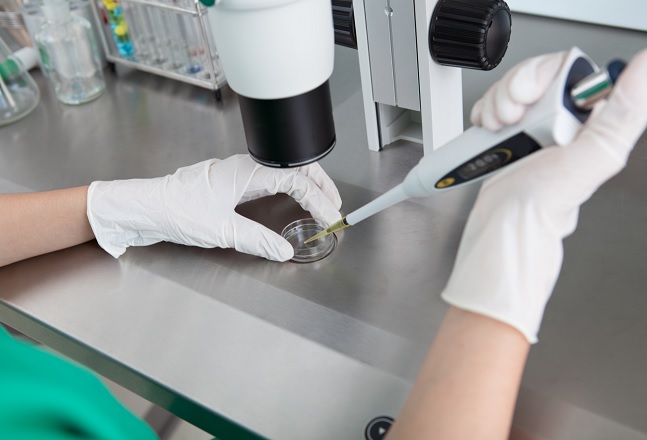Article contributed by:
Piedmont Reproductive Endocrinology Group, a participating WINFertility Provider NetworkOnce your retrieval is completed, other than taking your prescribed medications, there is nothing that you can do to positively affect your outcome. The best thing you can do to produce a healthy pregnancy is to rest and leave the embryo culture to us. Your doctor will need to relay pertinent information to you during your cycle so, please provide a number which you can be reliably reached.In attempts to alleviate your anxiety, we have outlined a day by day description of what we hope to see as your embryos develop.

Following your retrieval your physician will tell you how many oocytes (eggs) were recovered. Not all of the oocytes retrieved will be suitable for ICSI (intra-cytoplasmic sperm injection) or for conventional IVF. ONLY those oocytes that are mature will fertilize. Rule of thumb to remember, anything above 50% is good.

Woo Hoo! Normal Fertilization has occurred. Fertilization is noted by the presence of 2 pronuclei. This represents the chromosomal material from both you and your husband. Unfortunately at this stage, fertilization is all that we can tell. We can not accurately predict how the embryos will develop. Once again, a fertilization percentage of over 50% of your mature oocytes is good.

Each day of development there is an ideal cellular number that your embryos should obtain. At the first replication, hopefully your embryos will be between 2 to 4 cells. Anywhere in that range is perfectly normal.

Embryo transfers occur on D3 of development. Ideally your embryos should be approximately 8 cells. More importantly than specifically being 8 cells, it is critical that all cells within the embryos have replicated from the previous day… ie, if your embryos were 2 cells yesterday they should be at least 4 cells today. Assisted hatching is a technique utilized to produce a small hole within the embryo’s zona pellucida (cell membrane) that aids in implantation. It may be done on the day of your embryo transfer. If you are a patient undergoing PGD, (preimplantation genetic diagnosis) the embryo biopsy would be performed today.

The Morula stage is a very non- descript stage within embryo development. Cells within the embryo lose all configurations and adopt a “blob like” appearance. This occurs in order to allow for rapid cell division. Morula is consistent with approximately 25-50 cells.

Blastulation occurs immediately prior to hatching and implantation. It can begin to occur as early as late on D4 to late D6. By the time your embryos have progressed to the blast stage, they will have differentiated into what will become your fetus and into what will form accessory pregnancy material. By transferring on this later stage of development, we can more accurately pick the best embryos which will lead to a high pregnancy potential. However, the downfall for a blastocyst transfer is that the embryos will remain in a synthetic uterus for 2 more days. The best conditions we can create in the laboratory aren’t nearly as good as in your uterus. Therefore blastocyst transfer is reserved only for patients that have superior embryo quality. It is our recommendation that if your embryos are not perfect on Day 3, you do not consider the option of doing a blast transfer. Marginal embryos have a higher pregnancy potential when replaced on Day 3. At the time of your transfer you will be told a descriptive grade of each your transferred embryos.

This is the final day of your cycle. We will give your embryos every opportunity to develop, but unfortunately, if they are not showing blastulation by today the possibility that they will is very slim. All embryos that do not blastulate will be discarded.
Cryopreservation
In order to maximize your embryos not used for transfer, we will freeze embryos on D5 and D6. The day of cryopreservation is solely determined by embryo quality. Once frozen, your embryos will indefinitely remain at the stage in which they were at the time of cryopreservation. Consider frozen embryos a bonus to your fresh cycle and do not plan your fresh transfer on the fact that you may have frozen embryos. You can expect to lose a portion of your embryos as they go through the freeze and thaw process.PREG Embryo Transfer Guidelines
PREG is a member of The American Society for Reproductive Medicine (ASRM) and strives to strictly adhere to the guidelines outlined by the Society. ASRM is a non-profit organization that governs and maintains the highest ethical principles of the medical profession. Professionals in the fields of reproductive medicine, biology, and infertility must subscribe to the ASRM doctorialASRM released newly revised guidelines on the number of embryos to transfer during in vitro fertilization (IVF) procedures in October 2009. The guidelines are part of an ongoing effort to reduce the number of multiple births following fertility treatments. The guidelines now make clear that while exceptions may be allowable for patients with a less favorable prognosis; those exceptions are quite limited to only one more embryo than called for in the guidelines for transfer, regardless of prognosis. Additionally, guidelines are set regardless if resulting embryos are from a fresh or frozen IVF cycle.

 Following your retrieval your physician will tell you how many oocytes (eggs) were recovered. Not all of the oocytes retrieved will be suitable for ICSI (intra-cytoplasmic sperm injection) or for conventional IVF. ONLY those oocytes that are mature will fertilize. Rule of thumb to remember, anything above 50% is good.
Following your retrieval your physician will tell you how many oocytes (eggs) were recovered. Not all of the oocytes retrieved will be suitable for ICSI (intra-cytoplasmic sperm injection) or for conventional IVF. ONLY those oocytes that are mature will fertilize. Rule of thumb to remember, anything above 50% is good. Woo Hoo! Normal Fertilization has occurred. Fertilization is noted by the presence of 2 pronuclei. This represents the chromosomal material from both you and your husband. Unfortunately at this stage, fertilization is all that we can tell. We can not accurately predict how the embryos will develop. Once again, a fertilization percentage of over 50% of your mature oocytes is good.
Woo Hoo! Normal Fertilization has occurred. Fertilization is noted by the presence of 2 pronuclei. This represents the chromosomal material from both you and your husband. Unfortunately at this stage, fertilization is all that we can tell. We can not accurately predict how the embryos will develop. Once again, a fertilization percentage of over 50% of your mature oocytes is good. Each day of development there is an ideal cellular number that your embryos should obtain. At the first replication, hopefully your embryos will be between 2 to 4 cells. Anywhere in that range is perfectly normal.
Each day of development there is an ideal cellular number that your embryos should obtain. At the first replication, hopefully your embryos will be between 2 to 4 cells. Anywhere in that range is perfectly normal. Embryo transfers occur on D3 of development. Ideally your embryos should be approximately 8 cells. More importantly than specifically being 8 cells, it is critical that all cells within the embryos have replicated from the previous day… ie, if your embryos were 2 cells yesterday they should be at least 4 cells today. Assisted hatching is a technique utilized to produce a small hole within the embryo’s zona pellucida (cell membrane) that aids in implantation. It may be done on the day of your embryo transfer. If you are a patient undergoing PGD, (preimplantation genetic diagnosis) the embryo biopsy would be performed today.
Embryo transfers occur on D3 of development. Ideally your embryos should be approximately 8 cells. More importantly than specifically being 8 cells, it is critical that all cells within the embryos have replicated from the previous day… ie, if your embryos were 2 cells yesterday they should be at least 4 cells today. Assisted hatching is a technique utilized to produce a small hole within the embryo’s zona pellucida (cell membrane) that aids in implantation. It may be done on the day of your embryo transfer. If you are a patient undergoing PGD, (preimplantation genetic diagnosis) the embryo biopsy would be performed today. The Morula stage is a very non- descript stage within embryo development. Cells within the embryo lose all configurations and adopt a “blob like” appearance. This occurs in order to allow for rapid cell division. Morula is consistent with approximately 25-50 cells.
The Morula stage is a very non- descript stage within embryo development. Cells within the embryo lose all configurations and adopt a “blob like” appearance. This occurs in order to allow for rapid cell division. Morula is consistent with approximately 25-50 cells. Blastulation occurs immediately prior to hatching and implantation. It can begin to occur as early as late on D4 to late D6. By the time your embryos have progressed to the blast stage, they will have differentiated into what will become your fetus and into what will form accessory pregnancy material. By transferring on this later stage of development, we can more accurately pick the best embryos which will lead to a high pregnancy potential. However, the downfall for a blastocyst transfer is that the embryos will remain in a synthetic uterus for 2 more days. The best conditions we can create in the laboratory aren’t nearly as good as in your uterus. Therefore blastocyst transfer is reserved only for patients that have superior embryo quality. It is our recommendation that if your embryos are not perfect on Day 3, you do not consider the option of doing a blast transfer. Marginal embryos have a higher pregnancy potential when replaced on Day 3. At the time of your transfer you will be told a descriptive grade of each your transferred embryos.
Blastulation occurs immediately prior to hatching and implantation. It can begin to occur as early as late on D4 to late D6. By the time your embryos have progressed to the blast stage, they will have differentiated into what will become your fetus and into what will form accessory pregnancy material. By transferring on this later stage of development, we can more accurately pick the best embryos which will lead to a high pregnancy potential. However, the downfall for a blastocyst transfer is that the embryos will remain in a synthetic uterus for 2 more days. The best conditions we can create in the laboratory aren’t nearly as good as in your uterus. Therefore blastocyst transfer is reserved only for patients that have superior embryo quality. It is our recommendation that if your embryos are not perfect on Day 3, you do not consider the option of doing a blast transfer. Marginal embryos have a higher pregnancy potential when replaced on Day 3. At the time of your transfer you will be told a descriptive grade of each your transferred embryos. This is the final day of your cycle. We will give your embryos every opportunity to develop, but unfortunately, if they are not showing blastulation by today the possibility that they will is very slim. All embryos that do not blastulate will be discarded.Cryopreservation
In order to maximize your embryos not used for transfer, we will freeze embryos on D5 and D6. The day of cryopreservation is solely determined by embryo quality. Once frozen, your embryos will indefinitely remain at the stage in which they were at the time of cryopreservation. Consider frozen embryos a bonus to your fresh cycle and do not plan your fresh transfer on the fact that you may have frozen embryos. You can expect to lose a portion of your embryos as they go through the freeze and thaw process.PREG Embryo Transfer Guidelines
PREG is a member of The American Society for Reproductive Medicine (ASRM) and strives to strictly adhere to the guidelines outlined by the Society. ASRM is a non-profit organization that governs and maintains the highest ethical principles of the medical profession. Professionals in the fields of reproductive medicine, biology, and infertility must subscribe to the ASRM doctorialASRM released newly revised guidelines on the number of embryos to transfer during in vitro fertilization (IVF) procedures in October 2009. The guidelines are part of an ongoing effort to reduce the number of multiple births following fertility treatments. The guidelines now make clear that while exceptions may be allowable for patients with a less favorable prognosis; those exceptions are quite limited to only one more embryo than called for in the guidelines for transfer, regardless of prognosis. Additionally, guidelines are set regardless if resulting embryos are from a fresh or frozen IVF cycle.
This is the final day of your cycle. We will give your embryos every opportunity to develop, but unfortunately, if they are not showing blastulation by today the possibility that they will is very slim. All embryos that do not blastulate will be discarded.Cryopreservation
In order to maximize your embryos not used for transfer, we will freeze embryos on D5 and D6. The day of cryopreservation is solely determined by embryo quality. Once frozen, your embryos will indefinitely remain at the stage in which they were at the time of cryopreservation. Consider frozen embryos a bonus to your fresh cycle and do not plan your fresh transfer on the fact that you may have frozen embryos. You can expect to lose a portion of your embryos as they go through the freeze and thaw process.PREG Embryo Transfer Guidelines
PREG is a member of The American Society for Reproductive Medicine (ASRM) and strives to strictly adhere to the guidelines outlined by the Society. ASRM is a non-profit organization that governs and maintains the highest ethical principles of the medical profession. Professionals in the fields of reproductive medicine, biology, and infertility must subscribe to the ASRM doctorialASRM released newly revised guidelines on the number of embryos to transfer during in vitro fertilization (IVF) procedures in October 2009. The guidelines are part of an ongoing effort to reduce the number of multiple births following fertility treatments. The guidelines now make clear that while exceptions may be allowable for patients with a less favorable prognosis; those exceptions are quite limited to only one more embryo than called for in the guidelines for transfer, regardless of prognosis. Additionally, guidelines are set regardless if resulting embryos are from a fresh or frozen IVF cycle.



